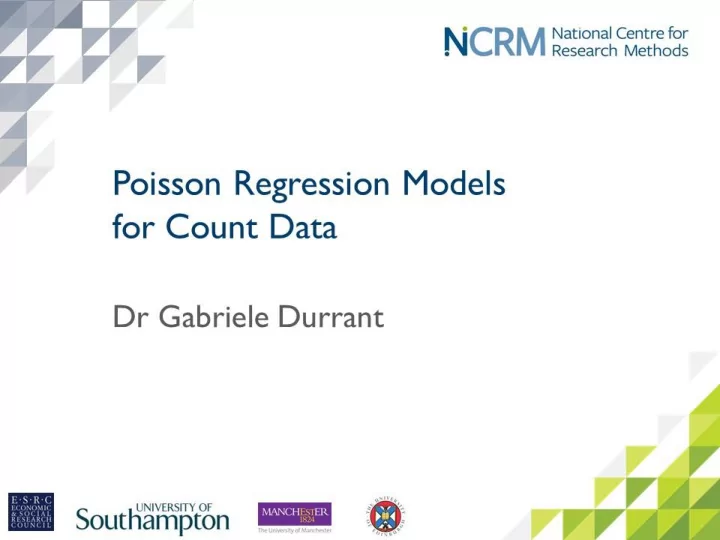

Poisson Regression Models for Count Data
Outline • Review • Introduction to Poisson regression • A simple model: equiprobable model • Pearson and likelihood-ratio test statistics • Residual analysis • Poisson regression with a covariate (Poisson time trend model) 2
Review of Regression You may have come across: Dependent Variable Regression Model Continuous Linear Binary Logistic Multicategory (unordered) Multinomial Logit (nominal variable) Multicategory (ordered) Cumulative Logit (ordinal variable) 3
Regression In this session: Dependent Variable Regression Model Continuous Linear Binary Logistic Multicategory (unordered) Multinomial Logit (nominal variable) Multicategory (ordered) Cumulative Logit (ordinal variable) Count variable Poisson Regression (Log-linear model) 4
Data Data for this session are assumed to be: • A count variable Y (e.g. number of accidents, number of suicides) • One categorical variable (X) with C possible categories (e.g. days of week, months) • Hence Y has C possible outcomes y 1 , y 2 , …, y C 5
Introduction: Poisson regression • Poisson regression is a form of regression analysis model count data (if all explanatory variables are categorical then we model contingency tables (cell counts)) . • The model models expected frequencies • The model specifies how the count variable depends on the explanatory variables (e.g. level of the categorical variable) 6
Introduction: Poisson regression • Poisson regression models are generalized linear models with the logarithm as the (canonical) link function. • Assumes response variable Y has a Poisson distribution, and the logarithm of its expected value can be modelled by a linear combination of unknown parameters. • Sometimes known as a log-linear model , in particular when used to model contingency tables (i.e. only categorical variables). 7
Example: Suicides (count variable) by Weekday (categorical variable) in France Mon 1001 15.2% Tues 1035 15.7% Wed 982 14.9% Thur 1033 15.7% Fri 905 13.7% Sat 737 11.2% Sun 894 13.6% Total 6587 100.0% 8
Introduction: Poisson regression • Let us first look at a simple case: the equiprobable model (here for a 1-way contingency table) 9
Equiprobable Model • An equiprobable model means that: – All outcomes are equally probable (equally likely). – That is, for our example, we assume a uniform distribution for the outcomes across days of week (Y does not vary with days of week X). 10
Equiprobable Model • The equiprobable model is given by: P(Y=y 1 ) = P(Y=y 2 ) = … = P(Y=y C ) = 1/C i.e. we expect an equal distribution across days of week. • Given the data we can test if the assumption of the equiprobable model (H 0 ) holds 11
Example 1: Suicides by Weekday in France Mon 1001 15.2% H 0 : Each day is Tues 1035 15.7% equally likely for suicides (i.e. the Wed 982 14.9% expected Thur 1033 15.7% proportion of Fri 905 13.7% suicides is 100/7 = 14.3% Sat 737 11.2% each day) Sun 894 13.6% Total 6587 100.0% 12
Example 2: Traffic Accidents by Weekday Mon 11 11.8% H 0 : Each day is Tues 9 9.7% equally likely for an accident (i.e. Wed 7 7.5% the expected Thur 10 10.8% proportion of Fri 15 16.1% accidents is 100/7 Sat 18 19.4% = 14.3% each day) Sun 23 24.7% Total 93 100.0% 13
Hypothesis Testing • H 0 : Each day is equally likely for an accident. • Alternative null hypotheses are: – H 0 : Each working day equally likely for an accident. – H 0 : Saturday and Sunday are equally likely for an accident. • Omitted variables? For example, distance driven each day of the week. 14
Poisson regression – without a covariate • We can express this equiprobable model more formally as a Poisson regression model (without a covariate), which models the expected frequency 15
Poisson regression • We assume a Poisson distribution with parameter μ for the random component, i.e. y i ~ Poisson(µ), i.e. • Y is a random variable that takes only positive integer values • m m Poisson distribution has a single parameter ( μ ) which is both its mean and its variance. - y e i i i P(Y = y ) = where y = 1,2,3 i i i y ! i 16
Poisson regression: Simple Model (No Covariate) • We aim to model the expected value of Y. It can be shown that this is the parameter μ , hence we aim to model μ . • We can write the equiprobable model defined earlier as a simple Poisson model (no explanatory variables), i.e. mean of Y does not change with month: E(y ) = = 1/ C m i i log( ) = i = 1, ,C m a i a = log(1/ ) C where is a constant. 17
Recommend
More recommend